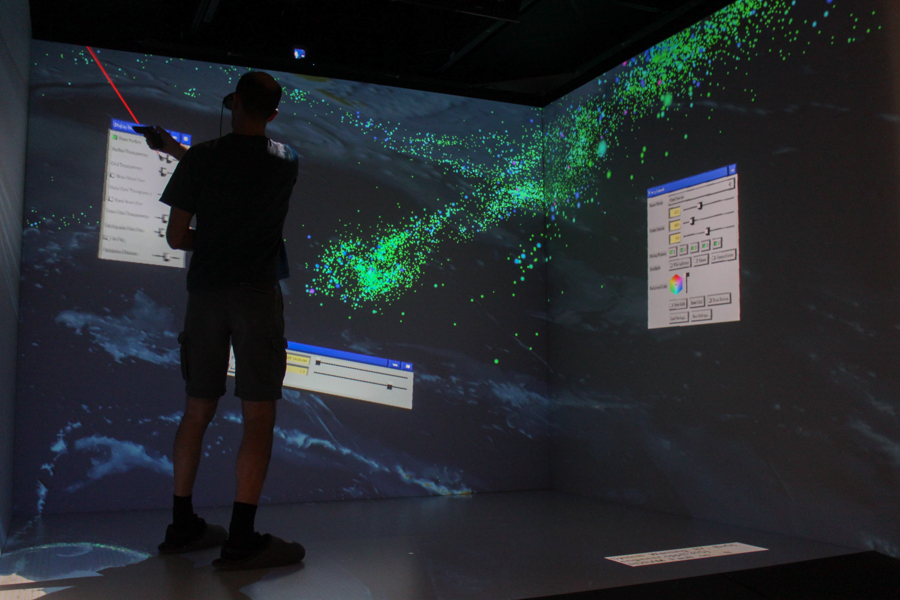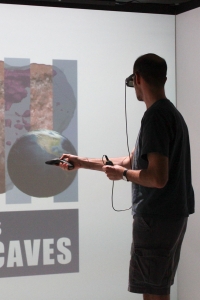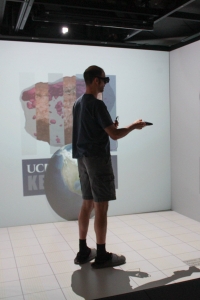
The KeckCAVES at UC Davis develop virtual reality system for scientific research.
From the Samsung Gear VR to the Oculus Rift, virtual reality (VR) has become a trending topic in the technological world. Here at UC Davis, researchers of KeckCAVES bring a unique twist to the VR experience.
The KeckCAVES is a collaborative project between Davis computer scientists and earth scientists who work to develop interactive 3D visualization for scientific data. The KeckCAVES faculty began working together in 2003, but the project did not officially start until 2004 when the group received funding from an organization called the Keck Foundation.

“It is an interdisciplinary project,” said Oliver Kreylos, computer scientist and software developer for KeckCAVES. “We have faculty from Computer Science and Earth and Physical Sciences. There’s roughly a dozen or so faculty involved in it.”
The primary feature of KeckCAVES is a cave automatic virtual environment (CAVE) located on campus in the Earth and Physical Sciences building. The CAVE consists of four large 10 by 8 feet screens — three walls and one floor — creating a boxlike space that provides users with a virtual reality environment for conducting scientific research. Having been built in 2005, the CAVE has been operating for eleven years.
The CAVE has been used for research in fields such as geology, astrophysics, oceanography and biology. Researchers bring collected data to the KeckCAVES faculty, who then use the data to either develop new programs or access previous programs that generate virtual CAVE settings for further research.
“[The purpose of KeckCAVES] is to enhance our ability to analyze large 3D data sets,” said Michael Oskin, a UC Davis geology professor and KeckCAVES research group member. “We can measure them, we can remeasure them, we can get statistics on them — we can do things people can’t do because they’re preserved in 3D and we can work with them in 3D.”
KeckCAVES has a YouTube channel titled “UC Davis KeckCAVES,” where demonstration videos of the CAVE and the KeckCAVES software are posted.
Since KeckCAVES’ software is mainly developed and used for research in science, it is distinctive from other virtual reality projects.
“There is nothing like this in another geology department in the country,” Oskin said. “There are other CAVEs around the country, this technology is not new, but [they’re] primarily a presentation tool as opposed to a research tool. That’s what makes [KeckCAVES] unique.”
Behind the screens of the CAVE is an elaborate system of electrical equipment, including six computers and four projectors. Images of objects and geographical settings are projected onto the screens, and when viewed with a pair of StereoGraphics CrystalEyes shutter glasses, the projections appear as 3D, hologram-like models that can be analyzed and manipulated through the use of a wireless controller.

“I like to call the CAVE itself a ‘holodeck for scientists.’ [It] allows a scientist [to] treat [data] almost like a physical object — except that you can do things with the virtual data that you can’t do with a real object,” said Dawn Sumner, UC Davis geology professor and chair of the Department of Earth and Planetary Sciences, in an email interview. “For example, you can make a rock transparent. Or you can look at the distribution of all the earthquakes recorded on Earth all at once. Or you can explore the structure of chaotic mathematical equations.”
In 2007, KeckCAVES collaborated with Sideshow Physical Theatre of the UC Davis Department of Theatre and Dance to produce the modern dance performance COLLAPSE (suddenly falling down). Through computer projections, KeckCAVES provided live, 3D scenery that dancers were able to interact with onstage. The production won an Isadora Duncan Dance Award.
The future of KeckCAVES will not lie in the CAVE itself, but rather the software, according to Kreylos. He predicts that CAVEs will become obsolete very soon, and therefore has been working to ensure that the KeckCAVES software can properly run on other pieces of hardware, mainly virtual reality headsets.
“Right now, the hardware is changing rapidly — very rapidly,” Kreylos said. “What wins out in technology is what most people embrace. Currently, what is being embraced is headsets.”
Written by Jennie Chang — features@theaggie.org



